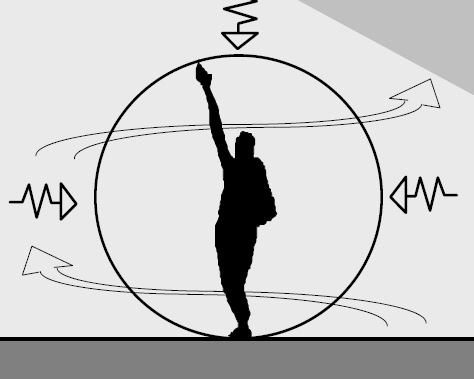Mean radiant temperature
All bodies exchange thermal radiation with their surroundings, depending on the difference in their surface temperatures and their emissivity. This radiant exchange is an important component of the thermal comfort that will be experienced by a person, particularly in places where there may be significant differences in radiant and air temperatures, for example, near a large window.
Other factors that influence thermal comfort include: environmental factors, such as air temperature, air velocity, relative humidity and the uniformity of conditions, as well as personal factors such as clothing, metabolic heat, acclimatisation, state of health, expectations, and even access to food and drink.
Mean radiant temperature (MRT) is a measure of the average temperature of the surfaces that surround a particular point, with which it will exchange thermal radiation. If the point is exposed to the outside, this may include the sky temperature and solar radiation.
The knowledge of surface geometries required to predict mean radiant temperature is very complex, particularly in elaborate spaces. However, mean radiant temperatures can be calculated by some proprietary software applications.
Mean radiant temperature can be measured using a globe thermometer. This is a hollow copper sphere painted matt black (to give it a high emissivity) with a temperature sensor at its centre.
From the temperature recorded, along with air velocity and air temperature (needed to account for convective heat exchange), the mean radiant temperature can be calculated:
MRT = globe temperature + 2.42 x air velocity in m/s (globe temperature – air temperature)
Note: This equation provides a very simplified rule of thumb. There are many different variations of this equation as it is dependent complex factors such as the size and emissivity of the globe thermometer. This particular example is taken from the Novalynx Corporation 2010, however, the units used in their equation appear to be incorrect, showing air velocity in cm/s rather than m/s. Thanks for pointing this out go to Dr Robert McLeod, Senior Lecturer Built Environment - Building Services Engineering, School of Environment and Technology at the University of Brighton.
[edit] Related articles on Designing Buildings Wiki
Featured articles and news
Homes England creates largest housing-led site in the North
Successful, 34 hectare land acquisition with the residential allocation now completed.
Scottish apprenticeship training proposals
General support although better accountability and transparency is sought.
The history of building regulations
A story of belated action in response to crisis.
Moisture, fire safety and emerging trends in living walls
How wet is your wall?
Current policy explained and newly published consultation by the UK and Welsh Governments.
British architecture 1919–39. Book review.
Conservation of listed prefabs in Moseley.
Energy industry calls for urgent reform.
Heritage staff wellbeing at work survey.
A five minute introduction.
50th Golden anniversary ECA Edmundson apprentice award
Showcasing the very best electrotechnical and engineering services for half a century.
Welsh government consults on HRBs and reg changes
Seeking feedback on a new regulatory regime and a broad range of issues.
CIOB Client Guide (2nd edition) March 2025
Free download covering statutory dutyholder roles under the Building Safety Act and much more.
Minister quizzed, as responsibility transfers to MHCLG and BSR publishes new building control guidance.
UK environmental regulations reform 2025
Amid wider new approaches to ensure regulators and regulation support growth.
BSRIA Statutory Compliance Inspection Checklist
BG80/2025 now significantly updated to include requirements related to important changes in legislation.
























Comments